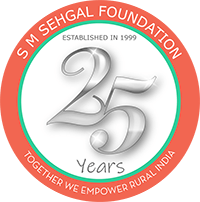By Vanessa Lopez
Before Sehgal Foundation provided help to the government schools of Untka, the students did not have access to drinking water. The water that the schools had was contaminated and had high levels of salinity. Sehgal Foundation was able to provide the school with a high-pressure recharge well, which now provides faculty and students with safe drinking water. The high-pressure well receives the rainwater that is stored in a large water tank. The water in the tank is rainwater that has been harvested through pipes connected to the roof of the building that collect the water. Before the water enters the high-pressure recharge well, it goes through a pre-filter that cleans the water of larger objects that could have been caught in the pipes or roof, such as leaves or paper. The water then goes to the tank; however this tank is different in the sense that it has no bottom. What is very interesting about this high-pressure recharge well is that the water that stays below the ground actually does not mix with the existing saline groundwater. Once students or faculty use the water, it goes through a biosand filter before it runs out of the faucet. Faculty have stated that children no longer have as many health issues related to high levels of salinity and biological contamination in the water. Sehgal Foundation even painted educational images on around the walls and main hallways of the school. One of the images they painted was that of the water cycle. The painting is simple and makes it easy for children to learn about environmental facts at an early age—the painting is both in Hindi and English. On the main wall of the school there is a painting explaining the work behind the high-pressure recharge well. It explains the number of gallons of clean water it provides for the school and how much the tank can hold. Since its completion, the well has been very successful in providing clean water for the students year round. This opportunity was very insightful and I am very thankful to Sehgal Foundation for allowing us to see their projects.
The visit to the schools really put things into perspective for me. I was aware that several countries and even certain places in the US had water issues—and they still do—however I never truly realized how privileged I am to have water safe enough to drink or water that does not have high levels of salinity. Being able to see these children happy, simply because the water they could drink at school did not give them stomach issues anymore, was very joyful and pleasing. It is vital that more people become educated about these issues and devote more time to helping those in need have basic human rights, such as water and food. No human should have to worry about whether the water they are drinking is going to affect their health or maybe even lead to their death.
(This is the edited version of the blog by, Vanessa Lopez, an undergraduate student, School of Public and Environmental Affairs: Indiana University, who visited Sehgal Foundation projects in Nuh, Haryana during March 2017)


